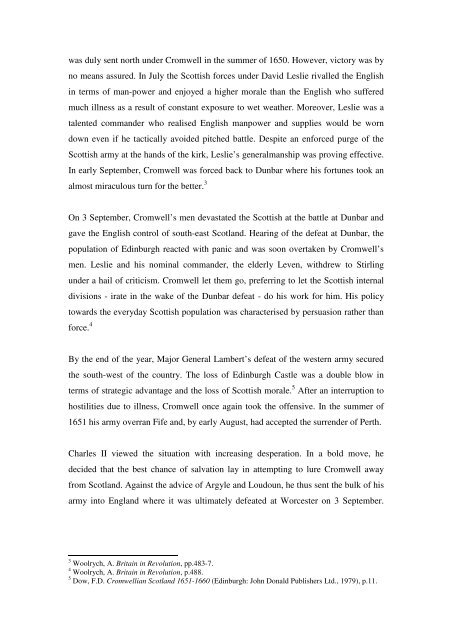The Glencairn Uprising, 1653-54 Helen Baker Department of ...
The Glencairn Uprising, 1653-54 Helen Baker Department of ...
The Glencairn Uprising, 1653-54 Helen Baker Department of ...
Create successful ePaper yourself
Turn your PDF publications into a flip-book with our unique Google optimized e-Paper software.
was duly sent north under Cromwell in the summer <strong>of</strong> 1650. However, victory was by<br />
no means assured. In July the Scottish forces under David Leslie rivalled the English<br />
in terms <strong>of</strong> man-power and enjoyed a higher morale than the English who suffered<br />
much illness as a result <strong>of</strong> constant exposure to wet weather. Moreover, Leslie was a<br />
talented commander who realised English manpower and supplies would be worn<br />
down even if he tactically avoided pitched battle. Despite an enforced purge <strong>of</strong> the<br />
Scottish army at the hands <strong>of</strong> the kirk, Leslie’s generalmanship was proving effective.<br />
In early September, Cromwell was forced back to Dunbar where his fortunes took an<br />
almost miraculous turn for the better. 3<br />
On 3 September, Cromwell’s men devastated the Scottish at the battle at Dunbar and<br />
gave the English control <strong>of</strong> south-east Scotland. Hearing <strong>of</strong> the defeat at Dunbar, the<br />
population <strong>of</strong> Edinburgh reacted with panic and was soon overtaken by Cromwell’s<br />
men. Leslie and his nominal commander, the elderly Leven, withdrew to Stirling<br />
under a hail <strong>of</strong> criticism. Cromwell let them go, preferring to let the Scottish internal<br />
divisions - irate in the wake <strong>of</strong> the Dunbar defeat - do his work for him. His policy<br />
towards the everyday Scottish population was characterised by persuasion rather than<br />
force. 4<br />
By the end <strong>of</strong> the year, Major General Lambert’s defeat <strong>of</strong> the western army secured<br />
the south-west <strong>of</strong> the country. <strong>The</strong> loss <strong>of</strong> Edinburgh Castle was a double blow in<br />
terms <strong>of</strong> strategic advantage and the loss <strong>of</strong> Scottish morale. 5 After an interruption to<br />
hostilities due to illness, Cromwell once again took the <strong>of</strong>fensive. In the summer <strong>of</strong><br />
1651 his army overran Fife and, by early August, had accepted the surrender <strong>of</strong> Perth.<br />
Charles II viewed the situation with increasing desperation. In a bold move, he<br />
decided that the best chance <strong>of</strong> salvation lay in attempting to lure Cromwell away<br />
from Scotland. Against the advice <strong>of</strong> Argyle and Loudoun, he thus sent the bulk <strong>of</strong> his<br />
army into England where it was ultimately defeated at Worcester on 3 September.<br />
3 Woolrych, A. Britain in Revolution, pp.483-7.<br />
4 Woolrych, A. Britain in Revolution, p.488.<br />
5 Dow, F.D. Cromwellian Scotland 1651-1660 (Edinburgh: John Donald Publishers Ltd., 1979), p.11.
















